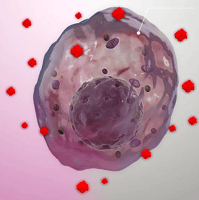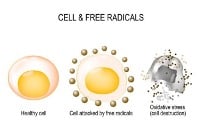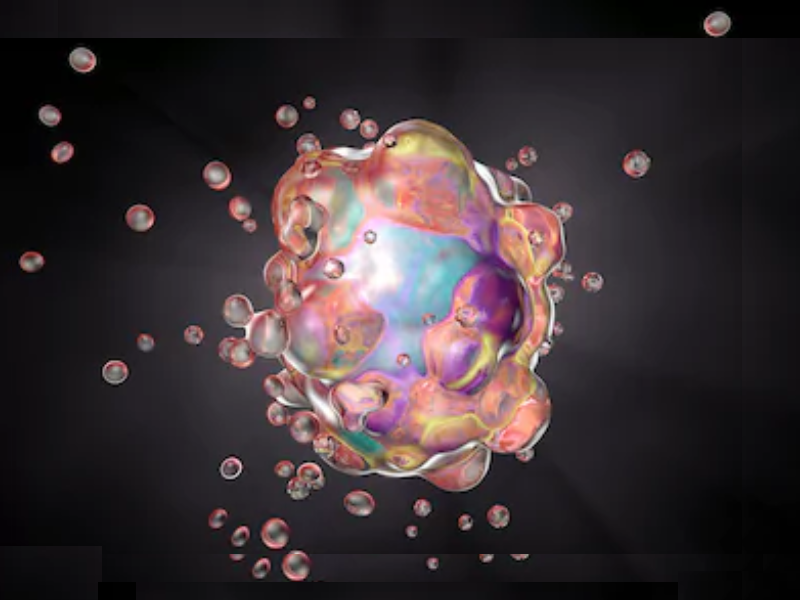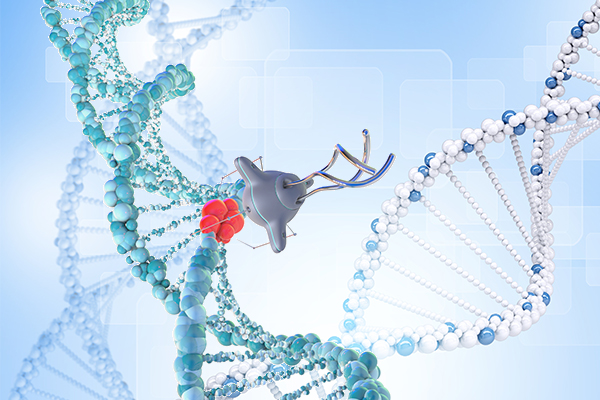 Oxidative stress is an imbalance between the production of reactive oxygen species (free radicals) and antioxidant defenses. [1] The body’s cells produce free radicals, which are nitrogen- or oxygen-containing molecules with an uneven number of electrons [2], during normal metabolic processes. [3] Meanwhile, cells also produce antioxidants that neutralize these free radicals to prevent excessive cell and tissue damage. In general, the body is able to maintain a balance between antioxidants and free radicals. [3] However, this balance could be disrupted under certain conditions or environmental stress or infection, and uncontrolled oxidative stress can accelerate the aging process.[3]
Oxidative stress is an imbalance between the production of reactive oxygen species (free radicals) and antioxidant defenses. [1] The body’s cells produce free radicals, which are nitrogen- or oxygen-containing molecules with an uneven number of electrons [2], during normal metabolic processes. [3] Meanwhile, cells also produce antioxidants that neutralize these free radicals to prevent excessive cell and tissue damage. In general, the body is able to maintain a balance between antioxidants and free radicals. [3] However, this balance could be disrupted under certain conditions or environmental stress or infection, and uncontrolled oxidative stress can accelerate the aging process.[3]
Effects of Oxidative Stress on the Body
 Free radicals play an essential role in several biological processes. Many of these are necessary for life, such as the intracellular destruction of bacteria by phagocytes, especially by granulocytes and macrophages. [4] Consequently, an excessive production of the free radicals determines structural modification of cellular proteins and the alteration of their functions, leading to cellular dysfunction and disruption of vital cellular processes. [5][6] Oxidative stress therefore could create damage to fatty tissue, DNA, and proteins in an individual’s body [2], contributing to a series of diseases, such as diabetes, atherosclerosis, inflammatory conditions, high blood pressure, and could even promote cancer development. [2] Factors leading to oxidative stress include a diet high in sugar, fat, and alcohol, as well as an environment with high pollution and radiation. [2][3]
Free radicals play an essential role in several biological processes. Many of these are necessary for life, such as the intracellular destruction of bacteria by phagocytes, especially by granulocytes and macrophages. [4] Consequently, an excessive production of the free radicals determines structural modification of cellular proteins and the alteration of their functions, leading to cellular dysfunction and disruption of vital cellular processes. [5][6] Oxidative stress therefore could create damage to fatty tissue, DNA, and proteins in an individual’s body [2], contributing to a series of diseases, such as diabetes, atherosclerosis, inflammatory conditions, high blood pressure, and could even promote cancer development. [2] Factors leading to oxidative stress include a diet high in sugar, fat, and alcohol, as well as an environment with high pollution and radiation. [2][3]
Source: MedicineNet
How ABclonal Can Help
Although much research is performed to alleviate the effects of oxidative stress on the cells and body, many scientists have also began to consider this phenomenon as an exploitable resource in treating diseases such as cancer and cardiovascular disorders. To assist you in your studies of free radicals, antioxidants, and how the body responds to oxidative stress, ABclonal offers a wide array of antibody products targeting the enzymes and markers associated with the maintenance of reactive oxygen species. A selection of our catalog is shown in the table below.
|
Category |
Target |
Cat.No. |
Product Name |
|
ROS production |
NADPH oxidase (NOX) |
NOX2/gp91phox Rabbit mAb |
|
|
NOX4 Rabbit mAb |
|||
|
Nitric oxide synthase (NOS) |
Phospho-eNOS-S1177 Antibody kit |
||
|
Cycloxygenase (COX) |
COX1 Rabbit mAb |
||
|
Lipoxygenase (ALOX) |
ALOX5 Rabbit mAb |
||
|
Xanthine oxidase (XOR) |
Xanthine Oxidase Rabbit mAb |
||
|
Cytochrome P450 |
Cytochrome P450 17A1 Rabbit mAb |
||
|
Cytochrome P450 2D6 Rabbit mAb |
|||
|
Antioxidases |
Superoxide dismutase (SOD) |
SOD1 Rabbit mAb |
|
|
SOD2 Rabbit mAb |
|||
|
Catalase (CAT) |
Catalase Rabbit mAb |
||
|
[One Step] CAT Antibody Kit |
|||
|
Glutathioneperoxidase (GPX) |
GPX1 Rabbit mAb |
||
|
GPX4 Rabbit mAb |
|||
|
Peroxiredoxin (Prdx) |
PRDX1 Rabbit mAb |
||
|
Peroxiredoxin 2 Rabbit mAb |
|||
|
[KO Validated] PRDX2 Rabbit pAb |
|||
|
PRDX5 Rabbit mAb |
|||
|
Thioredoxin reductase (TrxR) |
TXNRD1 Rabbit mAb |
||
|
TXNRD2 Rabbit mAb |
|||
|
Glutaredoxin (Grx) |
GLRX3 Rabbit pAb |
||
|
Heme oxygenase 1 (HO-1) |
Heme Oxygenase 1 Rabbit mAb |
||
|
NAD(P)H reductase 1 (NQO-1) |
NQO1 Rabbit mAb |
||
|
GSH generation |
Glutamate-cysteine ligase,catalytic subunit (GCLc) |
GCLC Rabbit mAb |
|
|
GCLC Rabbit pAb |
|||
|
Glutamate cysteine ligase, modifier subunit (GCLm) |
GCLM Rabbit mAb |
||
|
GCLM Rabbit pAb |
|||
|
Glutathione synthetase (GSS) |
Glutathione Synthetase Rabbit mAb |
||
|
[KO Validated] GSS Rabbit pAb |
|||
|
Glutathione reductase (GR) |
GSR Rabbit mAb |
||
|
NADPH generation |
Isocitratede hydrogenase 1 (IDH1) |
IDH1 Rabbit mAb |
|
|
IDH1 Rabbit pAb |
|||
|
Malic enzyme 1 (ME1) |
ME1 Rabbit pAb |
||
|
Glucose-6-phosphate dehydrogenase (G6PDH) |
G6PD Rabbit mAb |
||
|
Glutamate hydrogenase (GLUD) |
GLUD1 Rabbit mAb |
References
- https://pubmed.ncbi.nlm.nih.gov/10693912/
- https://www.healthline.com/health/oxidative-stress
- https://www.medicalnewstoday.com/articles/324863#what-is-it
- https://www.frontiersin.org/articles/10.3389/fphys.2020.00694/full
- Finkel, T., and Holbrook, N. J. (2000). Oxidants, oxidative stress and the biology of ageing. Nature 408, 239–247. doi: 10.1038/35041687
- Kaminski, K. A., Bonda, T. A., Korecki, J., and Musial, W. J. (2002). Oxidative stress and neutrophil activation—the two keystones of ischemia/reperfusion injury. Int. J. Cardiol. 86, 41–59. doi: 10.1016/s0167-5273(02)00189-4




